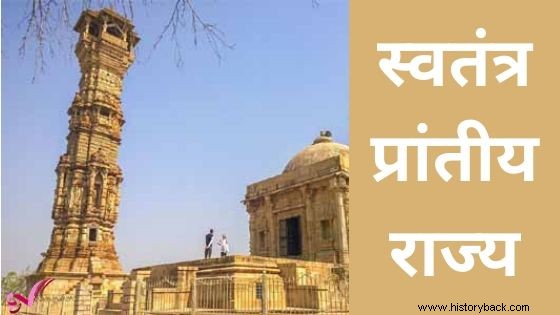Today in this article we will tell you Indian History in Hindi – Independent Provincial States Going to tell about.
Indian History in Hindi – Bahmani State
Independent Provincial State

k
Q. Who established the Hindu state in Kashmir?
Ans. Suhadeva in 1301 AD
Q. Who founded the Muslim dynasty in Kashmir?
Ans. In 1339 AD Shah Mir
Q. By what name did Shah Mir sit on the throne?
Ans. Shansuddin Shah Mir
Q. Who made Shah Mir his capital?
Ans. To Indrakot
Q. Where did Alauddin establish the capital away from Indrakot?
Ans. Alauddinpur (in Srinagar)
Q. When did Zain al-Abadin sit on the throne?
Ans. In 1420 AD
Q. By what other name was Zail-ul-Abadin called?
Ans. Akbar of Kashmir
Q. Which languages were known by Zain-ul-Abadin?
Ans. Persian, Sanskrit, Kashmiri and Tibetan
Q. In which language did Zain Al Abedin get the Mahabharata and Rajatarangini translated?
Ans. in Persian
Q. When did Akbar annex Kashmir to the Mughal Empire?
Ans. In 1588 AD
Jaunpur
Q. Who founded Jaunpur?
Ans. Firoz Shah Tughlaq
Q. Who founded the independent Sharqi dynasty in Jaunpur?
Ans. Malik Sarwar (Khwaja Jahan)
Q. Who gave the title of Malik Us Shark to Khwaja Jahan?
Ans. In 1394 AD Sultan Mahmud, son of Firoz Shah
Q. For how many years Jaunpur was independent?
Ans. Up to 75 years
Q. Who captured Jaunpur?
Ans. Bahlol Lodi
Q. Atala Devi's Mosque was built by whom?
Ans. Shurqi Sultan Ibrahim Shah in 1408 AD
Q. By whom was Jama Masjid built?
Ans. Hussain Shah Sharqi in 1470 AD
Q. Who built the Jhanjhari Masjid?
Ans. Ibrahim Sharqi in 1430 AD
Q. Who built the Lal Darwaza Masjid?
Ans. Muhammad Shah in 1450 AD
Bengal
Q. Who merged Bengal with the Delhi Sultanate?
Ans. Ikhtyaruddin Muhammad bin Bikhtiyar Khilji
Q. Into how many parts did Ghiyasuddin Tughlaq divided Bengal?
Ans. 3 (Lucknauti, Sonargaon and Satgaon)
Q. Who built Adina Masjid in Pandua?
Ans. Sultan Sikandar Shah in 1364 AD
Q. Which ruler of Bengal was famous for his justice?
Ans. Ghiyasuddin Azamshah
Q. Where did Alauddin Hussain Shah move his capital from Pandua?
Ans. In Gaur
Q. Mahaprabhu Chaitanya was a contemporary of which ruler?
Ans. Alauddin Shah's
Q. Which movement was started by Alauddin?
Ans. Satyaveer Movement
Q. Who composed Shri Krishna Vijaya during the reign of Alauddin?
Ans. Maladhar Basu
Q. Whose title did Maladhar Basu assume?
Ans. Gunraj Khan's
Q. Who built Badsona and Kadam Shrul Masjid in Gaur?
Ans. Nasiruddin Nusrat Shah
Malwa
Q. Who declared Malwa independent?
Ans. Dilawar Khan in 1401 AD
Q. Who was the successor of Dilawar Khan?
Ans. Alp Khan
Q. Whose title did Alap Khan assume?
Ans. Of Hushangshah
Q. When did Hushang become the ruler of Malwa?
Ans. In 1405 AD
Q. Where did Hushangshah move his capital from Dhara?
Ans. In Mandu
Q. Who founded the Khilji dynasty in Malwa?
Ans. Mahmud Shah
Q. Which ruler annexed Malwa to Gujarat?
Ans. Bahadur Shah
Q. Who built the fort of Mandu?
Ans. Hushang Shah
Q. What is most important in this fort?
Ans. Delhi Darwaza
Q. Who built the palace of Baz Bahadur and Roopmati?
Ans. Sultan Nasiruddin Shah
Q. Who built Hindola Bhawan or Durbar Hall?
Ans. Hushang Shah
Q. Who built the Jahaz Mahal in Mandu?
Ans. Ghiyasuddin Khilji
Q. Who built the mouse palace in Fatehabad?
Ans. Mahmud Khilji
Gujarat
Q. Who defeated the ruler of Gujarat, Raja Karna and merged it into the Delhi Sultanate?
Ans. Alauddin in 1297 AD
Q. By adopting whose title did Zafar Khan become the independent Sultan of Gujarat?
Ans. Sultan Muzaffar Shah in 1407 AD
Q. Who established the city of Ahmedabad on the banks of Sabarmati?
Ans. Ahmedabad
Q. Where did Ahmedabad shift its capital from Patna?
Ans. In Ahmedabad
Q. Who was the most famous ruler of Gujarat?
Ans. Mahmood Begda
Q. Who settled the city of Mustafabad near Girnar and Muhammadabad near Chammaner?
Ans. Mahmood Begad
Q. When did Akbar annex Gujarat to the Mughal Empire?
Ans. In 1572 AD
Mewar
Q. Who annexed Mewar to the Delhi Sultanate by defeating Ratan Singh, the ruler of the Guhilaut dynasty of Mewar?
Ans. Alauddin Khilji in 1303 AD
Q. Which ruler defeated Muhammad Tughlaq and liberated Mewar?
Ans. Hammir Dev of Sisodia dynasty
Q. Who established the 'Vijay Pillar' in Chittor?
Ans. In 1448 AD, Rana Kumbha
Q. Between whom was the battle of Khanwa fought in 1527?
Ans. Rana Sanga and Babur
Q. Who won the Khanwa war?
Ans. Babur's
Q. Between whom was the battle of Haldi Ghati fought in 1576 AD?
Ans. Between Rana Pratap and Akbar
Q. Who won the Haldi Ghati war?
Ans. Akbar's
Q. What was the capital of Mewar?
Ans. Chittorgarh
Q. Which ruler annexed Mewar to the Mughal Empire?
Ans. Jahangir
Khandesh
Q. Who founded Khandesh?
Ans. Ahmad Raja Faruqi in 1382 AD
Q. Between which rivers was Khandesh situated?
Ans. Narmada and Tapti
Q. What was the capital of Khandesh?
Ans. Burhanpur
Q. Where was the military headquarters of Khandesh?
Ans. In Asirgarh
Q. Who annexed Khandesh to the Mughal Empire?
Ans. Akbar in 1601 AD
Today in this article we have given you Indian History in Hindi – Independent Provincial States, Rise of Provincial States, Independent Provincial States, Independent Provincial States – Bharatkosh, Knowledge, Provincial, If you want any other information related to this, then you can also ask by commenting in the comment box.
